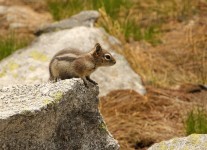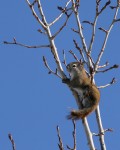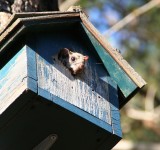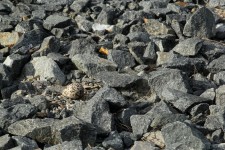Standing bolt upright on a prominent rock, a Columbian ground squirrel chirps every now and then as I watch from Shorty Peak lookout. The chirps are telling other ground squirrels that a potential predator is nearby–me.
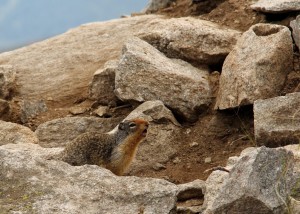
Columbian ground squirrels are 10 to 12 inches from head to toe with bright orange underparts and limbs. The top of their nose is deep orange and their brown grizzled tail has white to cream edges. Other ground squirrels in their range (golden-mantled ground squirrels in North Idaho) are smaller and do not have the orange limbs and belly.
Columbian ground squirrels are among the most social ground squirrels and they make several noises to alert others in their colony of predators. Aerial predators (such as hawks and eagles) elicit a rapid series of loud chirps while terrestrial predators (such as coyotes and bobcats) elicit a few, well-spaced chirps. If more of a threat is nearby, the ground squirrel chatters its teeth.
The ground squirrels constantly look for predators as they forage for food in the short time-span they are active. Columbian ground squirrels typically become active in March or April and enter hibernation in July or August, depending on whether they are male or female.
After mating season (immediately after waking from hibernation), the males quickly gain weight by eating as much as possible of plants, seeds, insects, fruit, eggs, small vertebrates and carrion. By the time the hottest weather in July and August arrives, the males are so plump they are at risk of overheating and they enter hibernation.
Females enter hibernation later because they cannot gain weight until after they have weaned their young. By entering hibernation later, the females also wake up a few weeks later than the males–at about the same time as the first shoots of grass are poking through the soil.
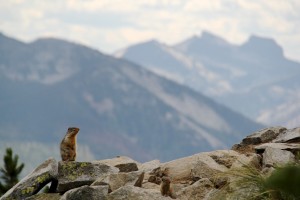
Columbian ground squirrels watch for predators that include bears, coyotes, marten, badgers, mountain lions, red-tailed hawks, long-tailed weasels, snakes, bobcats and eagles.
Since the males wake up from hibernation before the first greens, they cache food (seeds and bulbs) within their hibernaculum before they enter hibernation. The ground squirrel’s hibernaculum is a special chamber in its burrow that is sealed off from the rest of the burrow with a plug of dirt.
Within the hibernaculum is a dome-shaped nest of finely shredded grasses and drainage holes in the floor to prevent flooding in the spring and fall. Young of the year spend their first winter in the same burrow system as their mother but in separate chambers. This practice is thought to increase the survival rate of the young to 87 percent.
Once the young emerge in the spring, the females usually stay in the same colony while males disperse. The males will move from their natal range and establish residence among a different colony of females.
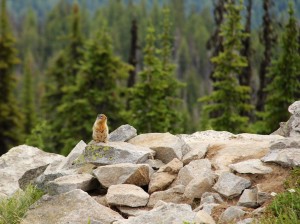
The majority of their diet is grass, plant stems, leaves, bulbs, fruits and seeds but they also eat birds, insects and other small animals on occasion. Preferred food is dandelion, timothy, clover and yarrow.
All colonies have a complex dominance hierarchy and they greet each other by “kissing”. By living in large colonies, there are more eyes to scan for predators in the alpine and sub-alpine meadows, woodlands and grasslands they occupy. The ground squirrels tend to scan for predators more often later in the summer because they are so plump they don’t move as fast.
They also can overheat in the afternoon sun and will retreat to their burrows to sprawl out on the cool dirt to lower their body temperature. Once the heat becomes to intense for their plump bodies, they retreat to their burrows for another seven to eight month hibernation and the chirping on the mountain tops ceases for another season.

